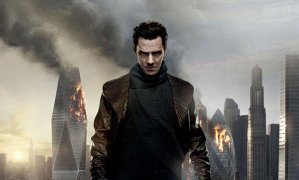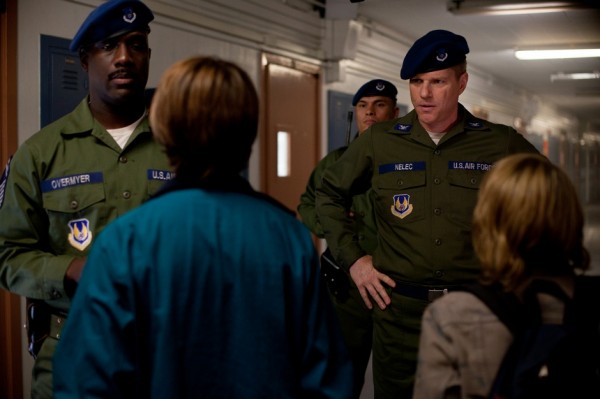J. J. Abrams is not bashful about 9/11. He blew up the Vulcan home world in his 2009 Stark Trek reboot and said afterwards he was aiming for the World Trade Center. The sequel, Stark Trek Into Darkness, literally spells it out with a 9/11 dedication in the ending credits. Not that anyone was going to miss the parallels. An enormous, hijacked spaceship takes a suicidal plunge into a 20th century-looking cityscape and levels a block of skyscrapers? I think we’ve seen this episode before.
I admit I was startled, teetering on repulsed, to see such extreme 9/11 imagery employed for mere box office fun. And the movie really is fun. Osama Bin Laden is played by Stark Trek uber-villain Khan, who’s played by—no, not the Corinthian leather guy in the white, Fantasy Island suit, but Benedict Cumberbatch, who BBC fans already adore as their most recent Sherlock (in addition to commandeering a starship, Benedict dethroned Basil Rathbone for most flamboyantly named Holmes actor).
Cumberbatch also plays Adolf Hitler. In Star Trek mythology, Khan is the abortive product of the so-called Eugenics Wars of the 1990s. Here on our Earth, we call that World War II. The Nazis were exterminating unfit races in the service of a cleaner, ubermensch-friendly gene pool. Cumberbatch’s Khan even boasts a strain of Dalek (a latent BBC gene presumably) and so wants to expand his extermination program to a universal scale.
I’ve written elsewhere (“Heirs of Slytherin the Virginia State House”) how eugenics keeps providing Hollywood with 21st century supervillains, including most recently Voldemort, Magneto, Red Skull, and the Lizard. In my theater, Khan was scheming a room over from Iron Man 3, where evil genius Aldrich Killian upgrades himself and his minions into the “new iteration of human evolution.” But Abrams is less interested in the war of the fittest than the War on Terror.
It turns out our C.I.A. drones are fueled, literally, by more of those evil supermen. The military brass want Kirk to fire them at a targeted terrorist. No trial, no jury, just a remote control execution, what the U.S. authorizes daily in the Middle East. Obviously Spock objects. And soon we learn a rogue admiral is undermining the very principles that America—I mean, the Federation—was founded on.
The Enterprise was always a Cold War vehicle, so there’s some whiplash in the political retooling. The admiral is Peter Frederick Weller, reprising his equally treasonous role from season five of 24 (a franchise Fox is planning to reboot too). Weller wants to safeguard us against wars to come, but the real threat is the lure of vengeance. Even a liberal-blooded half-Vulcan can long to beat the murderer of his best friend into uber-pulp. But that won’t bring him back to life. Only the DNA-fit blood of a still-living superman can do that. So listen to your girlfriend, and keep your phasers on stun.
Despite the striking plot parallels, I doubt Star Trek Into Darkness is going to stir the same waters as Zero Dark Thirty. Which is too bad. More people have already seen it. Science fiction is an especially apt vehicle for allegory—though also one easily ignored (I’m still astonished how season 3 of Battlestar Galactica, an overt representation of the U.S. occupation of Iraq told from the sympathetic POV of human suicide bombers against their literally inhuman oppressors, all but escaped political analysis). American consumers prefer their entertainment entertaining, not thought-provoking. A fact Mr. Abrams fully embraces. His Star Treks are satisfying romps, spiced with just enough current events to create a pleasing patina of relevance.
The reboot of Khan is first and foremost a reboot of Khan. It even prompted my wife and son and I to look up the original episode on Hulu. For all its talk of selective breeding, the 1967 “Space Seed” is, I was surprised to find, anything but eugenically correct. Ricardo Montalbán is Mexican, a mixed ethnicity any self-respecting eugenicists would have stamped as unfit. And he plays an Indian, the warlord of a continent far far below the standards of Aryan supremacy. Eugenicists wanted to weed out not just the East, but Eastern Europe, those migrating degenerates endangering the genes that produce the likes of, say, Benedict Cumberbatch.
I don’t object to Gene Roddenberry scrambling the history books, not any more than I do Mr. Cumberbatch finding lucrative employment (Sherlock Holmes was exterminated after The Hobbit abducted his Watson, Martin Freeman). He and Zachary Quinot’s Spock (remember his villainous days on Heroes?) are ideal opponents, two super-muscled brainiacs ready to kill each other for their loved ones. Nimoy’s Spock makes a cameo too (Abrams, thankfully, does not re-explain the not-quite-a-reboot reboot premise), reminding us that noble principles (I vow never to interfere with your timeline) are plot fodder when it’s William Shatner’s doppelganger on the line.
So, yes, vanquish the supermen of evils past, put the pesky military in its Constitutional place, and let’s get this five-year mission underway. To boldly go (fifty years later, and we’re still splitting that damn infinitive) where we apparently can’t help ourselves from going again and again and again.


